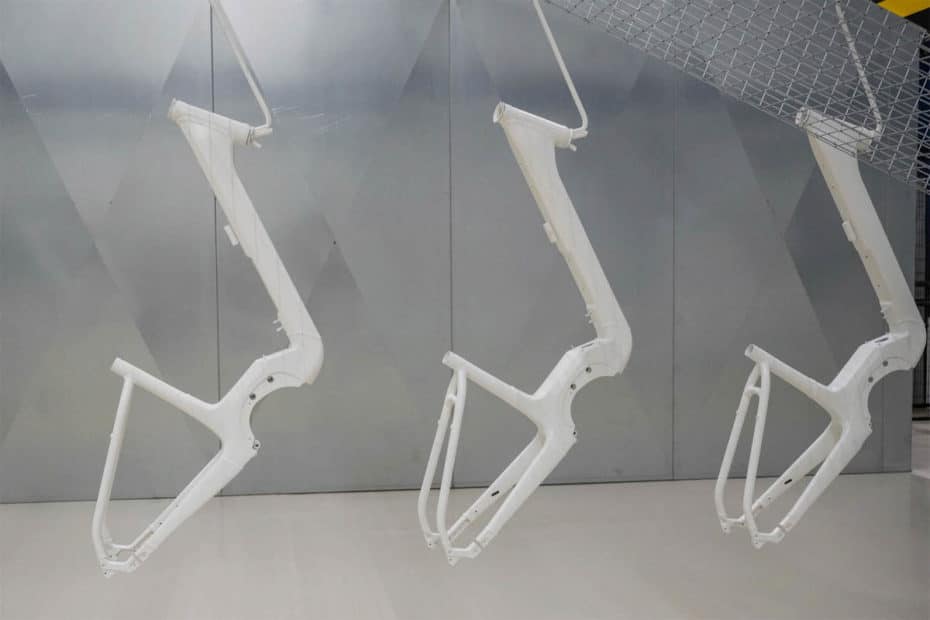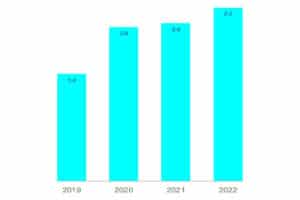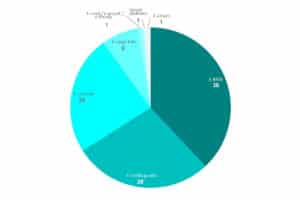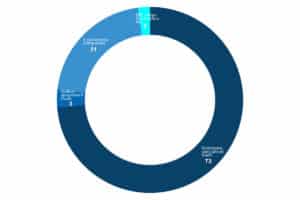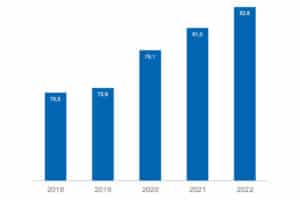This is how far apart perceived and actual reality sometimes are. Perceived, significantly fewer ebikes must have been sold last year than before, because the year basically consisted of waiting rather than paying and riding. In fact, the amount of ebikes sold in 2022 reached a record high. This is according to figures now presented by the German Zweirad-Industrie-Verband (ZIV) in Berlin.
1. How many ebikes were sold in Germany in 2022?
2. How much money is spent on an ebike?
3. What are the most popular types of ebike?
4. Where do people buy?
5. Ebike stock in Germany
6. Ebike production in Germany
7. Export of ebikes from Germany
8. Import of ebikes to Germany
9. Forecast for 2023
According to the ZIV, the balance could have been even more positive. However, a certain reluctance to buy was noticeable towards the end of the year, explained ZIV Managing Director Burkhard Stork. This primarily affected the medium-priced and low-priced assortment. Uncertainty about the development of the gas price and the level of energy prices in general had made people act more cautiously. Stork cited the significantly higher inflation rate as another brake on sales.
1. How many ebikes were sold in Germany in 2022?
Despite such difficult general conditions, the sale of ebikes even recorded a double-digit growth rate. The number of new ebikes increased by almost exactly ten percent compared to 2021. A total of 2.2 million units were sold through a wide variety of sales channels in Germany. Just four years ago, in 2018, the figure was just one million.
If you look at regular bicycles and ebikes together, sales have even declined slightly compared to 2021. The minus of around 100,000 units is solely due to bicycles without electric assistance. Nevertheless, a total of 4.6 million bicycles were sold, which is about 300,000 more than in the pre-Corona year 2019.
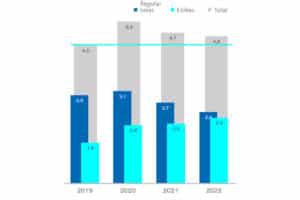
Summary of the number of bikes with and without electric assistance sold in Germany from 2019 to 2022
Ebikes and bicycles almost on a par in terms of sales
This means that the passing of e-bikes over regular bicycles predicted last year by the ZIV for 2022 is still waiting to happen. However, with a ratio of 48 per cent to 52 per cent, as well as taking into account the trends for both bicycle categories, a bet on the first-time top spot for ebikes in the sales rankings for next year promises only a small winning rate.
“In some product groups, such as mountain bikes or cargo bikes, we now have a very clear dominance of assisted vehicles in Germany,” said Stork at the press conference in Berlin. The mountain bikes mentioned already give a foretaste of the future balance of power. Of the 931,600 mountain bikes sold in Germany, 836,000 were models with an e-drive. According to Adam Ries, that adds up to a proud 89.7 percent.
2. How much money is spent on an ebike?
The amount people in Germany spend on an ebike also increases with the number of units. We have now reached 2,800 euros. This is the average across all types of ebikes. In addition, there is no distinction made between shopping at the DIY shop, the bike shop around the corner or Porsche’s car dealership. The value determined in the same way for regular bikes is 500 euros.
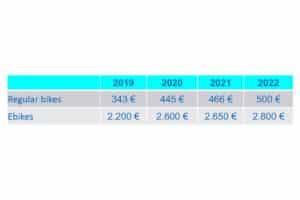
Overview of the average price of a bicycle sold with and without electric assistance in Germany from 2019 to 2022
3. What are the most popular types of ebike?
In the favour of buyers, the e-mountain bike is in the lead for the second time in a row. With a gap of ten and fourteen percentage points, respectively, it now leaves the long-standing favourites and e-trekking bikes as well as city e-bikes clearly behind. Thanks to an increase of 23 percent, the E-MTB is once again the best-selling segment within the group of ebikes. E-trekking bikes and e-city bikes cannot quite keep up. Their sales figures are stable at a high level, but have only increased by four and 1.5 percentage points respectively.
Speed pedelecs, e-cargo bikes and sporty ebikes, which the ZIV groups together in its statistics under road bike, gravel bike and fitness bike, are in a completely different sphere. The latter group is growing by a staggering 120 percent. However, this is happening at a very modest level. Around 22,000 of them were sold in Germany in 2022.
In contrast, there is more substance behind the figures for e-cargo bikes. The increase to 165,000 bikes sold means a plus of 37.5 percent. Both private and commercial use are obviously boosting demand.
4. Where do people buy?
In addition to the question of what is bought, the statistics of the ZIV always provide information about where people finally buy their new ebike. At this point, behaviour has not changed. In fact, you could transfer the values from 2021 almost 1:1 to those for 2022. The first port of call for purchases is still the stationary specialised trade with 73 percent. The companies that sell their ebikes exclusively via the internet follow at a great distance. They were able to increase their share by one percent to 21 percent. The remaining shares are accounted for by the online offers of the specialised trade as well as hypermarkets, DIY shops and discounters.
5. Ebike stock in Germany
Together with the ebikes purchased last year, Germany now has 82.8 million bicycles. Statistically, this means that there is one bicycle for every person in this country – with or without e-drive. According to the ZIV, this is far from the end of the road. Among other things, a noticeable trend towards a second bicycle can be observed. Cyclists would more often buy different bicycles for different purposes, for example a bicycle with electric assistance and one without, or one for leisure and one for commuting, or one for themselves personally and a cargo bike as a sort of “family vehicle”. Burkhard Stork also emphasised that the purchase is not merely a consumer pleasure. With the increased number of bicycles, more kilometres are being covered. Thus, cycling as such is growing and expanding its position as a serious alternative to the car.
6. Ebike production in Germany
The strong sales figures are underpinned by bicycle production, which is also reporting a new record. In 2022, 2.6 million bicycles and ebikes were produced in Germany. That is another 230,000 units more than in 2021, which was already an all-time high at the time. The production of regular bicycles has remained constant at 900,000 units. The increase is solely due to ebike production. This rose by 20 per cent to 1.72 million units.
7. Export of ebikes from Germany
The largest customer for the ebikes produced here continues to be the Netherlands. However, at 24 percent, ten percent less went to our neighbouring country than in 2021. Austria and France, which each ordered 12 percent, follow in second and third place in this ranking, also countries directly bordering Germany. At more than 98 percent, almost all of the ebikes exported from Germany go to countries in the European Union or to countries in the European Free Trade Association (EFTA).
8. Import of ebikes to Germany
In recent months, several German ebike manufacturers have opened new production facilities within Europe. This is reflected in the import figures. This reached a peak of 1.45 million units. And in contrast to regular bicycles, the majority of them now come from the EU. The ZIV shows 69 per cent in its balance sheet. By comparison, Asia is still slightly ahead in this category with 52 percent of regular bicycles. Greater independence from price developments in the customs area and anti-dumping duties on imports of ebikes from China are two of the reasons that make production in Europe increasingly attractive for manufacturers.
9. Forecast for 2023
Given several positive records, the mood among the ZIV participants at the press conference was understandably upbeat. This did not dampen when the outlook for 2023 was discussed. According to Burkhard Stork, the industry association expects a somewhat turbulent year. The warehouses of many dealers are filled to the rafters, which is due to overproduction from last year and the simultaneous decline in demand. With partly massive price reductions, first the online trade and later also the stationary trade tried to ease this situation before and after the turn of the year. Therefore, now is a suitable time to profit from the price reductions here and there and go home with a bargain. Because once the current oversupply has been worked off, prices will return to normal. Once this market shakeout is mastered, “more great years” lie ahead for the bicycle industry, Stork concluded his forecast.
Pictures: ZIV Zweirad-Industrie-Verband

